Pistachio Dacquoise cake is hands down the best thing I have ever tasted. I don't say that lightly. Chewy, crispy, and smooth all at the same time and bursting with authentic pistachio flavor. If you're a pistachio lover, you absolutely have to try this.

Reader Review:
Oh.My.God. I've never made dacqoise, never made french buttercream, but this recipe is AMAZING. I will never go back to American buttercream again! It's so delicious. I just can't even describe the delicacy of the flavors and the lightness!
⭐⭐⭐⭐⭐ - Cathy
I have unwittingly become the queen of pistachio desserts. It's a flavor I adore and so love to bake with. The most successful recipe on my whole blog is my Pistachio Cake, and I've got similar delicious creations such as my Pistachio Shortbread Cookies and my Pistachio Cheesecake. But this Pistachio dacquoise absolutely takes the cake (hehe).
Made entirely with real pistachios and no artificial flavoring, the pistachio flavor is absolutely unreal. The crunchy, chewy meringue cake layers mixed with the glossy, smooth pistachio French buttercream is simply heavenly.
Jump to:
Why You'll Love This Recipe
- It's a symphony of sweet, salty, nutty, chewy, crispy, and smooth in every bite!
- Easy to make but very impressive.
- A very unique dessert to serve at special occasions.
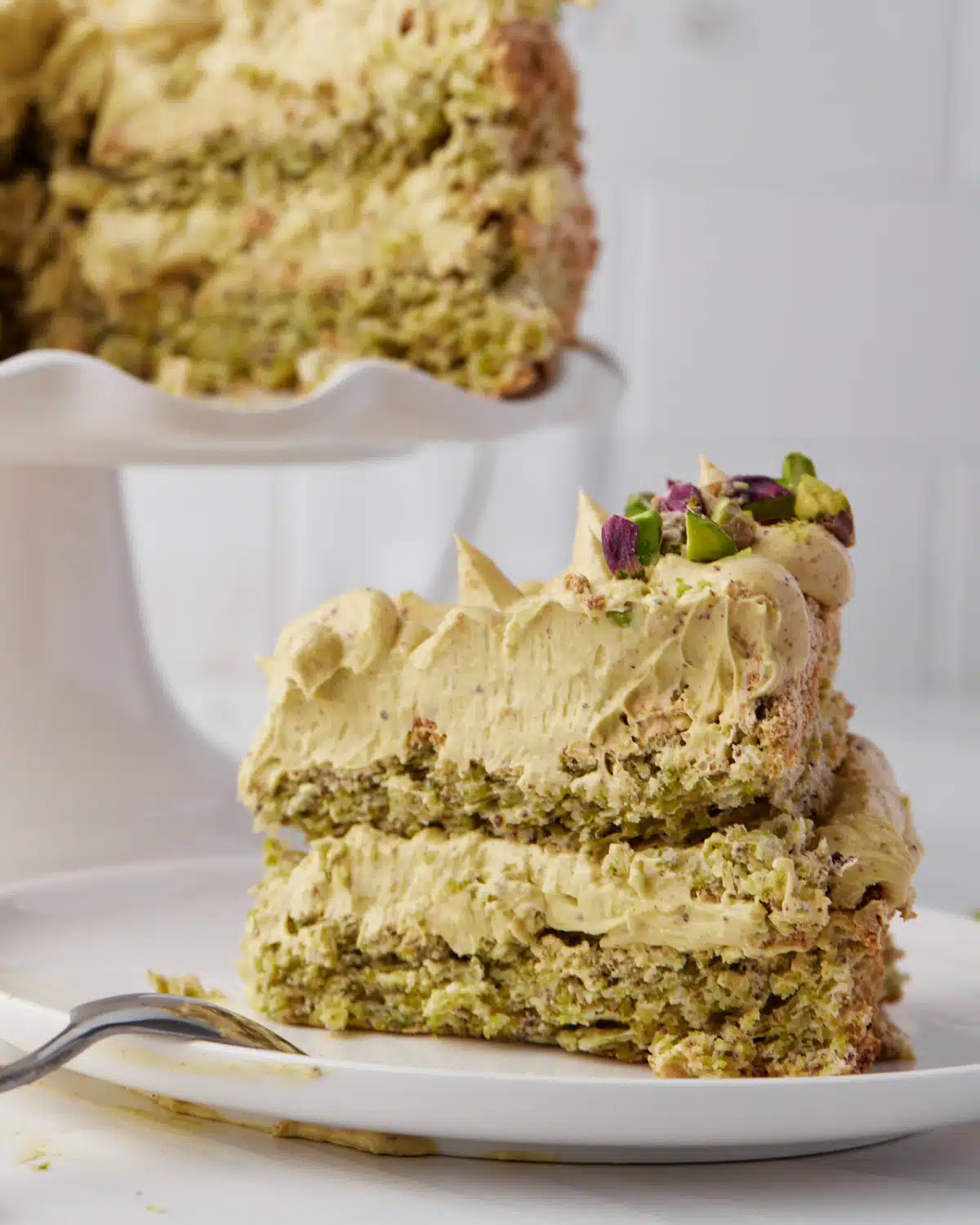
What is Dacquoise?
Dacquoise is a French dessert made from a meringue and ground nut mixture. It is typically layered with filling such as sweet whipped cream, pastry cream, and buttercream.
Traditionally, dacquoise is made with almonds or hazelnuts, but I wanted to develop this recipe to use my favorite nuts and make a decadent pistachio version.
Dacquoise (pronounced 'DA-kwahz') originated from southwestern France in the 17th century. Its name comes from the French word, 'dacquois', meaning 'Dax' - the town where it was invented.
The term 'dacquoise' actually refers to both the nutty meringue layer that is made, as well as the finished dessert once it is all put together.
Ingredients
For such an elevated dessert, this pistachio dacquoise recipe calls for relatively simple ingredients.
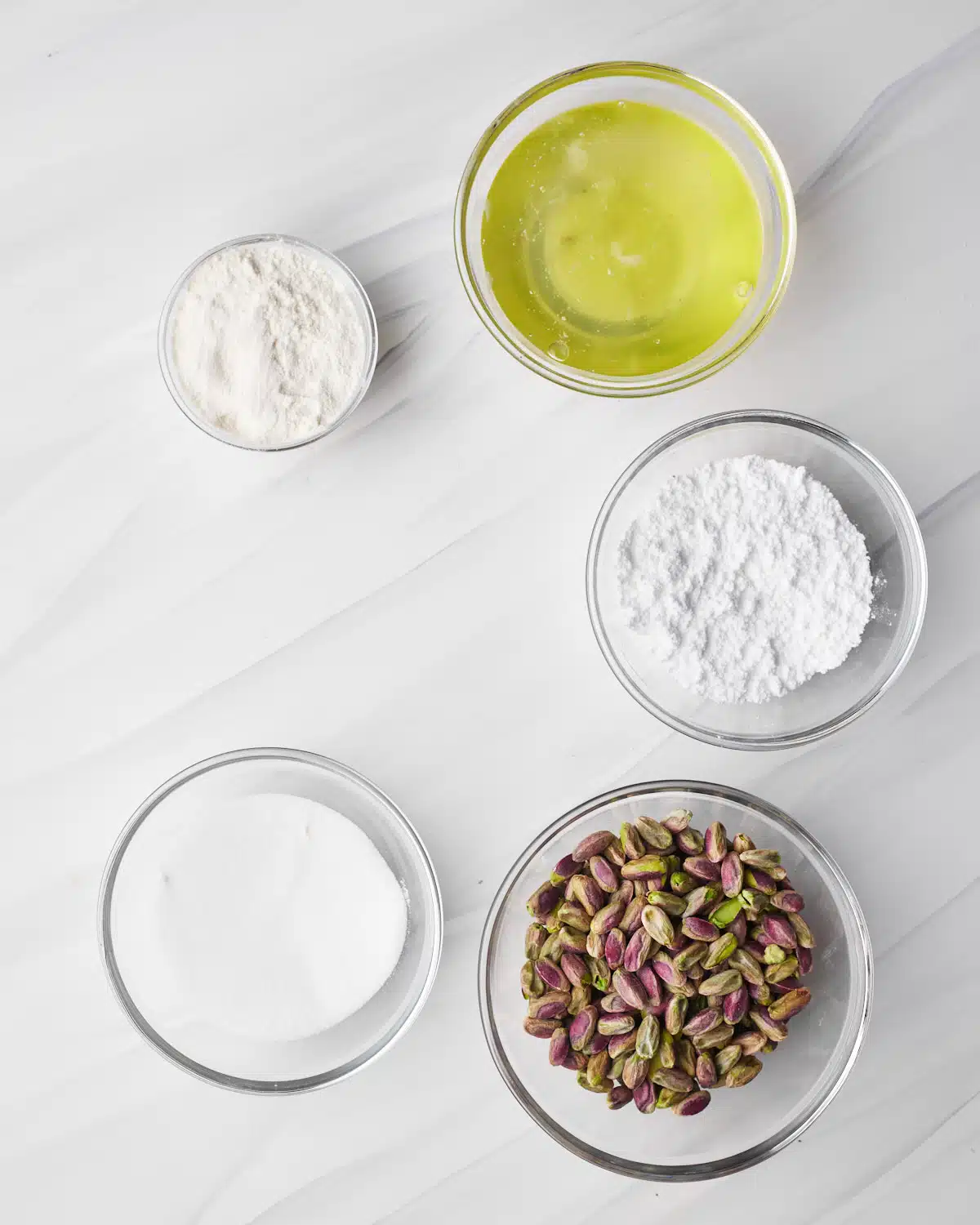
- Pistachios - The star of the show - pistachios! I like to buy mine pre-shelled to save a bit of hard work and some sore fingers. If your pistachios are salted, you can leave the salt out from the rest of the dacquoise recipe.
- Powdered Sugar - Also known as confectioners' sugar or icing sugar, it's the super fine, powder-like sugar.
- Cake Flour - I recommend cake flour for dacquoise cake as it has a lower gluten content and is lighter, which makes it less likely to deflate the meringue than all-purpose flour. If you don't have cake flour you can still make this with all-purpose flour.
- Eggs - We'll use the large egg whites to make the meringue for the dacquoise cake, and we'll use the egg yolks (plus a few extras) to make the French buttercream.
- Sugar - Superfine white sugar (caster sugar) is best so it can dissolve into the egg whites easily.
- Cream of Tartar - This helps to stabilize the meringue but it is not necessary for the success of the recipe. If you don't have it you can substitute for twice as much lemon juice, or leave it out entirely. You'll just have to be extra careful not to knock too much air out of the meringue when folding.
- Salt - I feel like the salt is unskippable for this pistachio dacquoise cake - it really brings out the nutty flavor and balances out the sweetness of the pistachio frosting.
- Butter - Unsalted butter is best so you can control he salt levels. Make sure the butter is at room temperature before you make the frosting.
- Pistachio Paste - The French buttercream will be flavored with pistachio paste. You can either buy pre-made pistachio paste, or you can easily make your own pistachio paste with just some pistachios and a food processor.
See the recipe card for quantities.
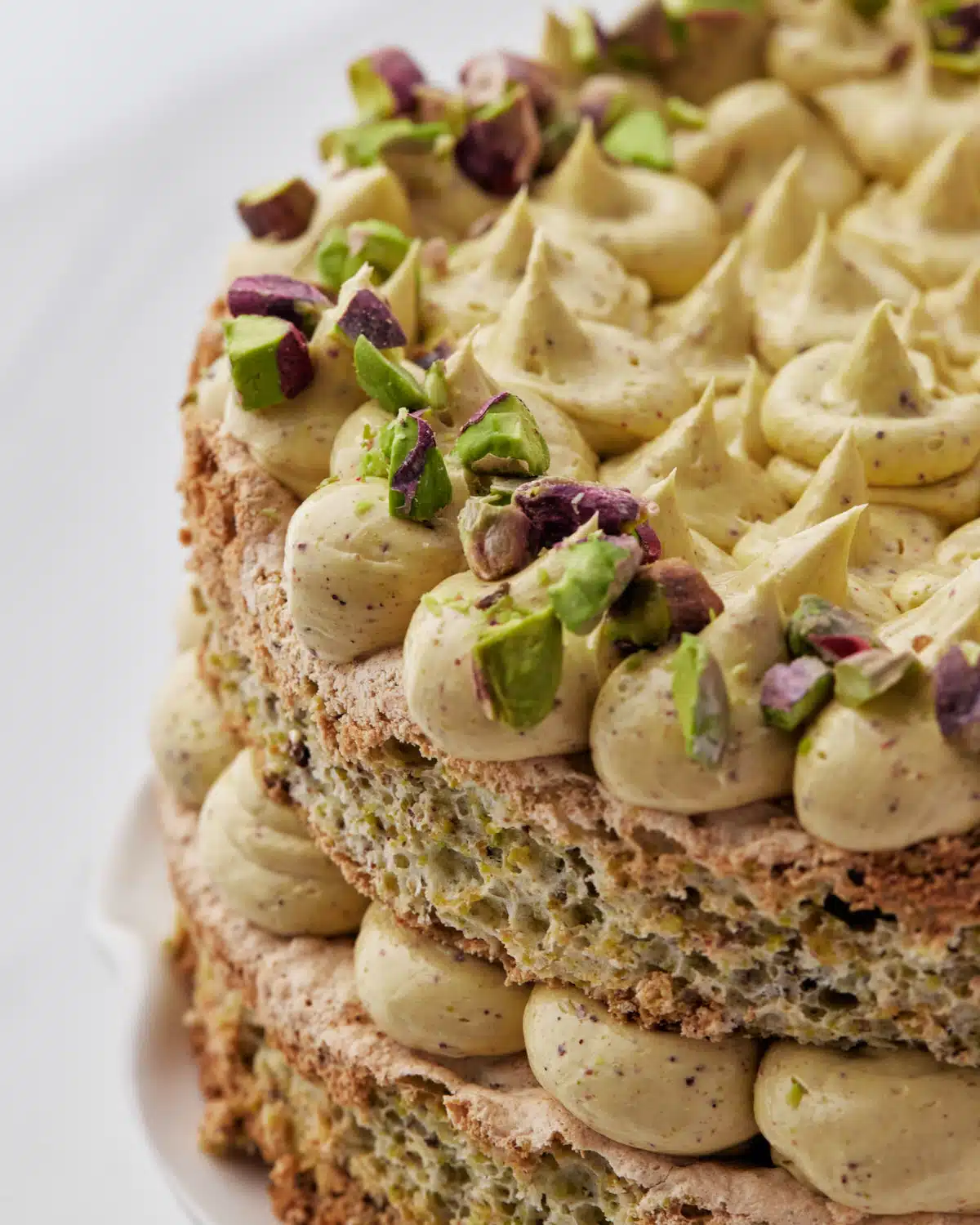
How to Make Dacquoise
The process to make the dacquoise cake is actually very straightforward. We're basically going to make pistachio flour, then make meringue, and then gently fold the two together and bake. That's it!
Preheat oven to 465°F / 240°C and line a large baking sheet with parchment paper. Place two cake rings on the parchment paper - do not grease them. Don't have cake rings? See the Equipment section below for alternatives.
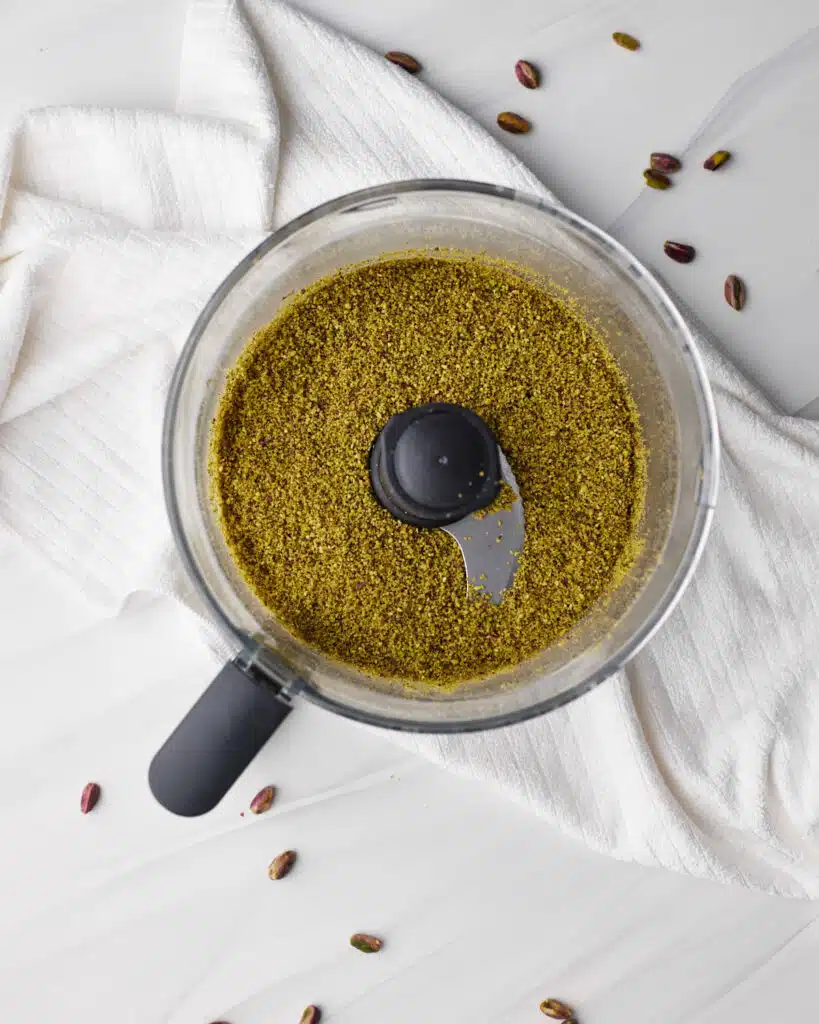
Make Pistachio Flour
Put your pistachios into a food processor and pulse until they are in fine pieces. They will go through several stages of different sizes, make sure you get them as small as you can, but don't blitz for too long or you may end up with pistachio paste.
If they start to feel moist, stop and don't go any further, this is the oil starting to release which will make pistachio butter.
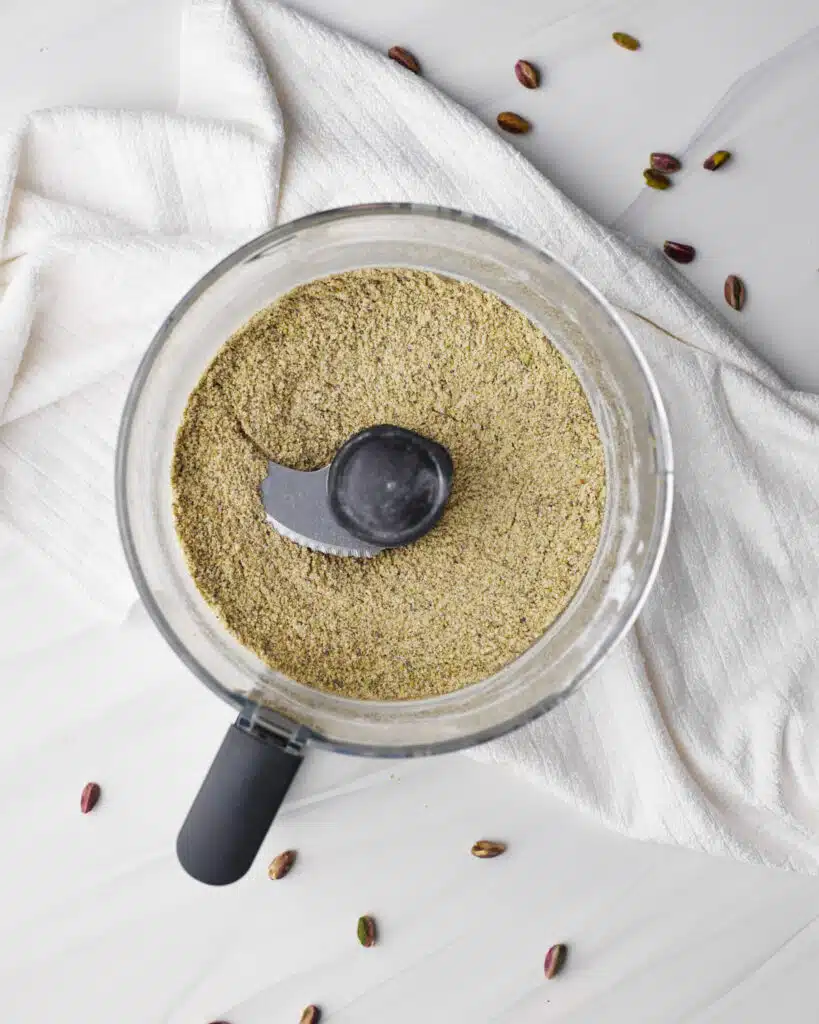
Add Dry Ingredients
Once the pistachios are ground as finely as you can get them, add the powdered sugar and cake flour and pulse a few more times until everything is combined.
The mixture should now look like nice, fine pistachio flour. Set aside.
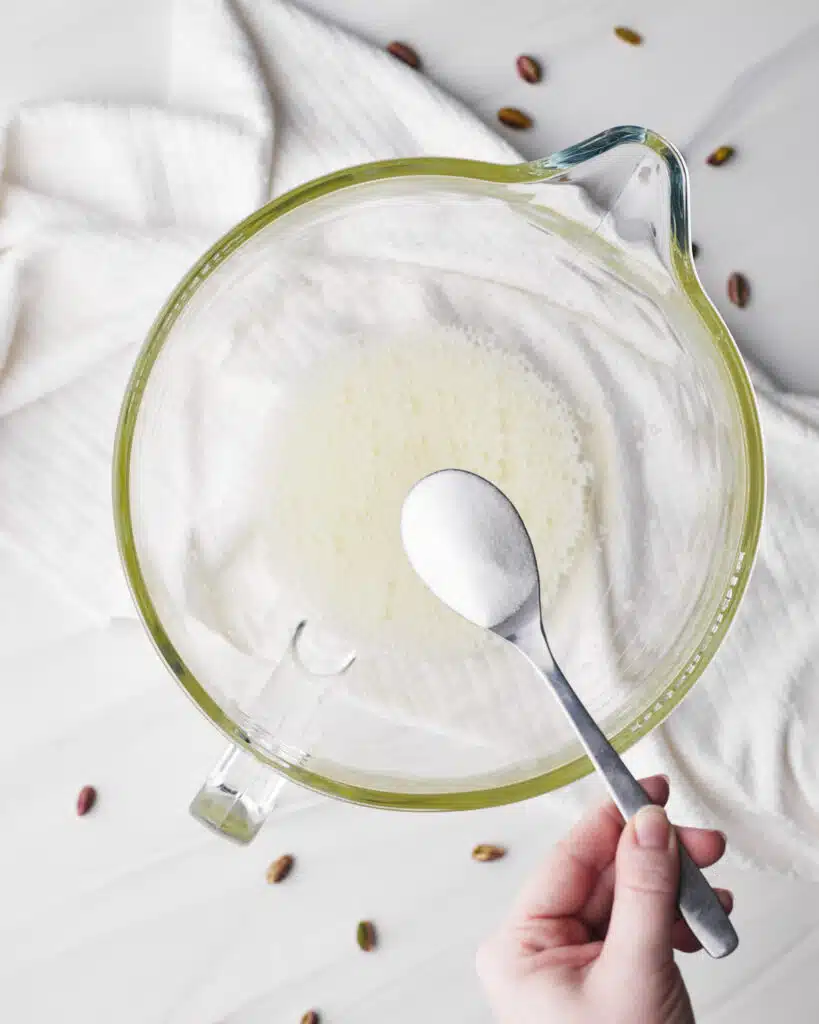
Make Meringue
In the bowl of a stand mixer, start whipping up the room temperature egg whites with the whisk attachment on medium speed until they start to get frothy, then add the cream of tartar and a pinch of salt, and turn up to medium-high speed.
Start adding your sugar, one tablespoon at a time, letting it mix in for at least 30 seconds in between. If you add the sugar too quickly it won't dissolve properly and you'll be left with a grainy meringue.
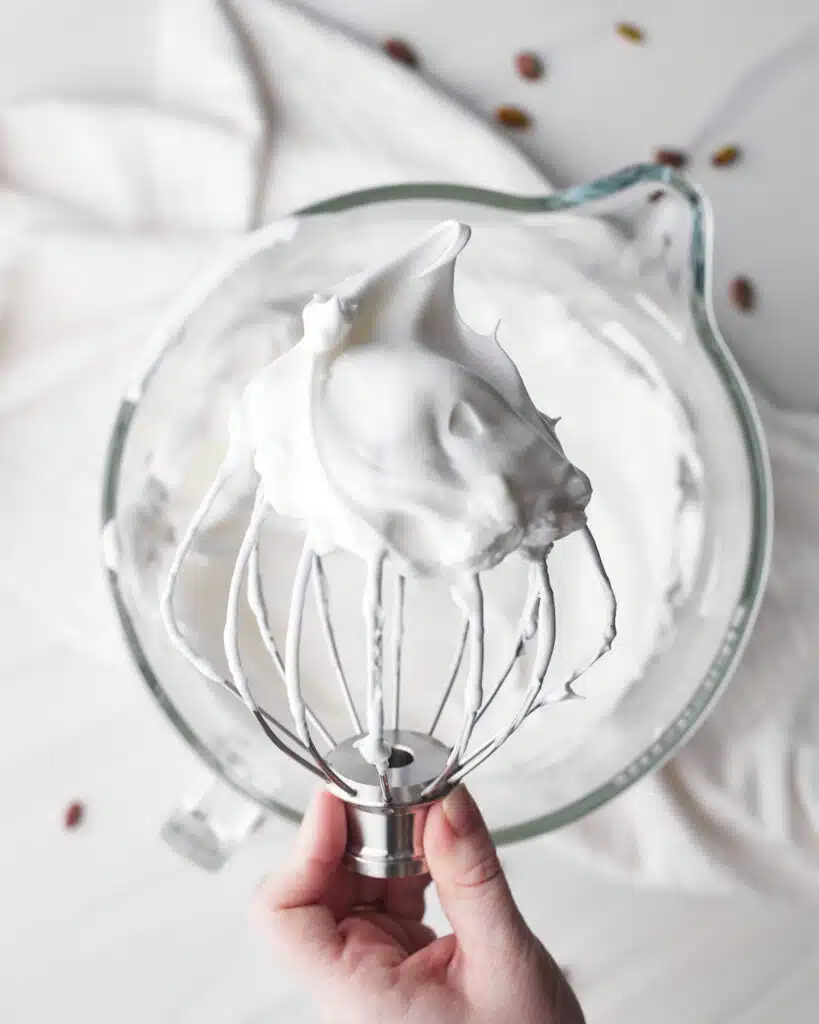
Check the Meringue
Once all the sugar is incorporated, you should have a thick, glossy meringue that is whipped to stiff peaks.
If you rub a little of it between your fingers there should be no grains at all. If it is grainy or the meringue isn't stiff enough, whip on high speed for a little longer until the desired consistency is reached.
It's really important for the meringue to be whipped enough so that it will hold more of the air when folded with the pistachio flour.
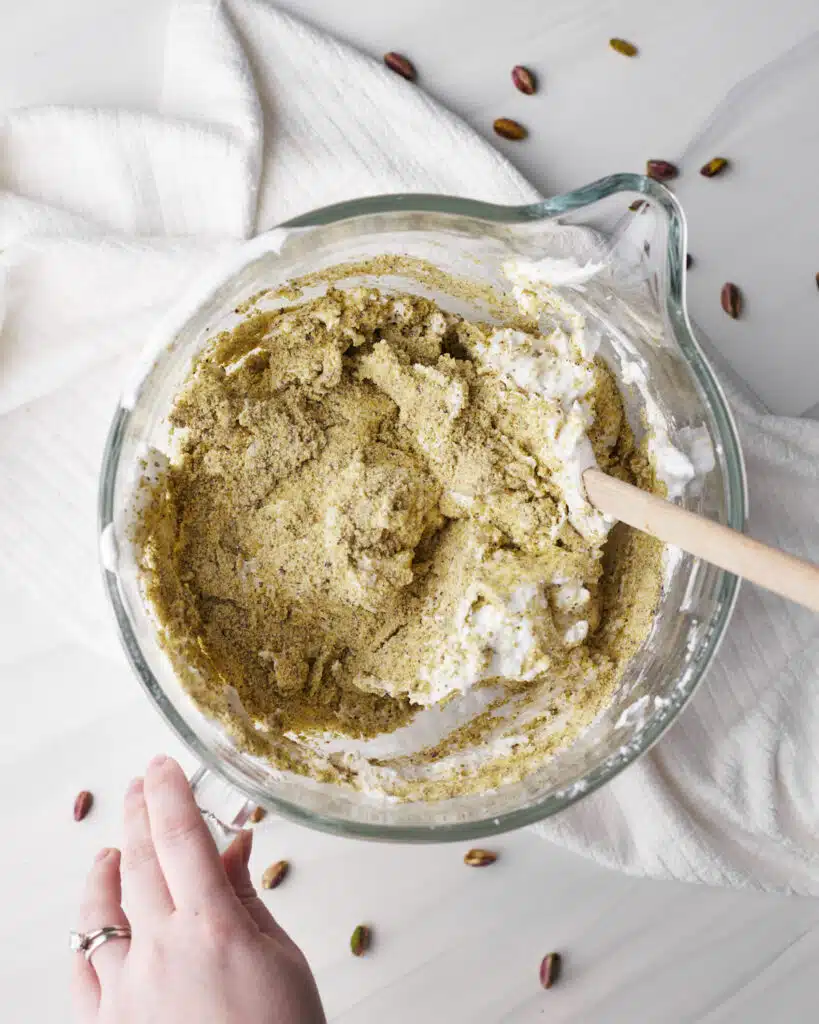
Fold in the Pistachio Flour
Pour half of the nut mixture into the meringue and gently fold it in with a rubber spatula, being careful not to knock out too much of the air.
Once incorporated, add the remaining pistachio mixture and fold in completely, again being very gentle and careful not to knock out the air.
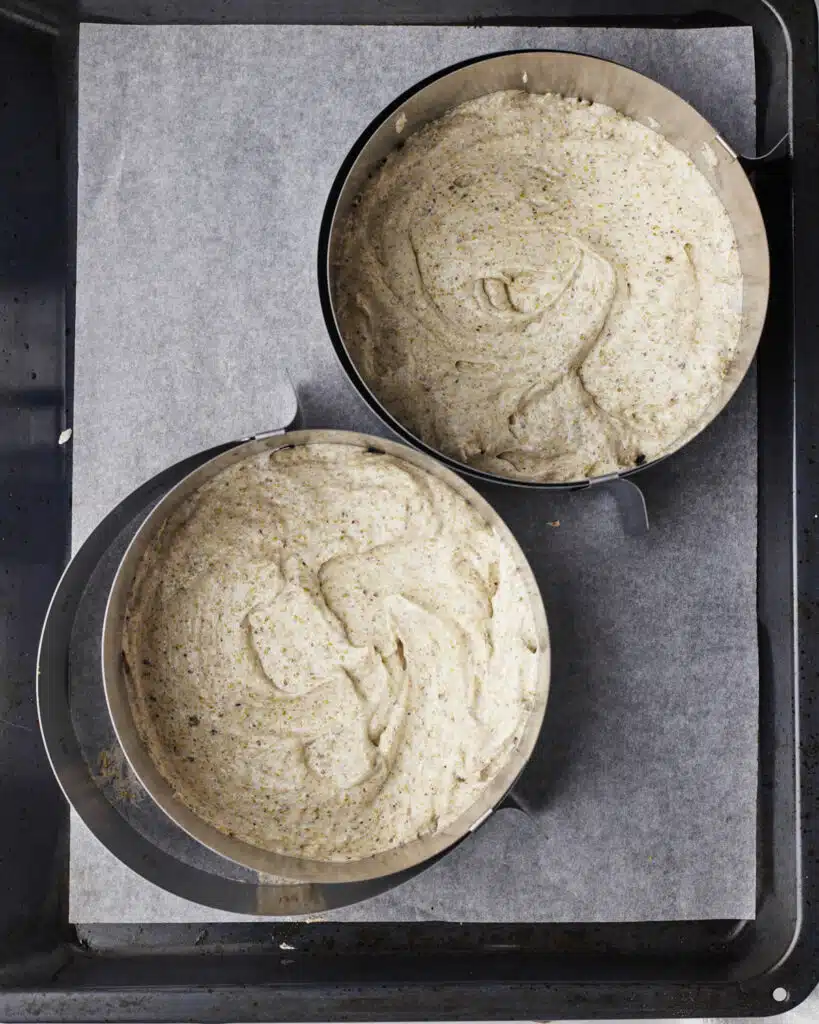
Bake
Divide your nut meringue between the two pastry rings (or spread onto pieces of parchment paper in a circle shape) and use an offset spatula or palette knife to spread them out as evenly as possible.
Put your dacquoise into the oven and immediately turn the oven temperature down from 465°F / 240°C to 350°F / 180°C. Bake for 15 minutes.
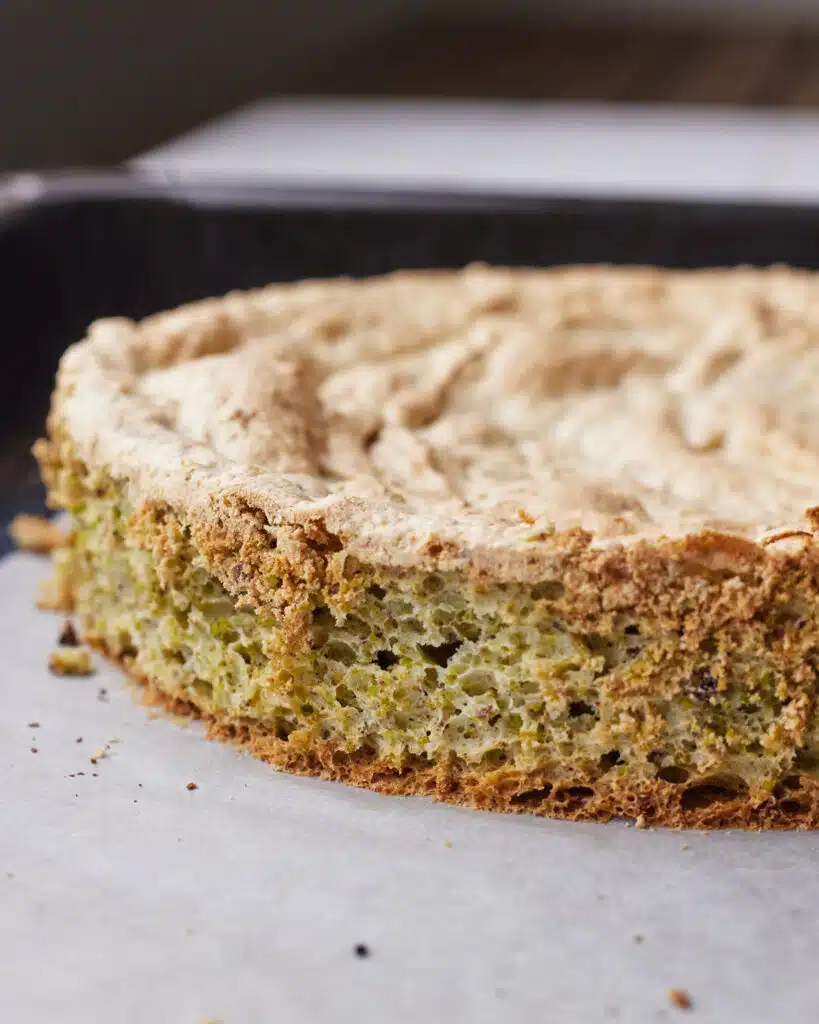
Cool
After 15 minutes, turn off the oven and open the oven door slightly. Leave the dacquoise to cool in the oven for at least an hour before removing them and allowing them to cool completely on the countertop.
Once the dacquoise have completely cooled, carefully run a sharp knife around the edge of the cake rings and release them
They should be light and slightly crispy on top. Carefully peel the dacquoise cake off of the parchment paper.
Tip: I always recommend weighing your ingredients with a kitchen scale, rather than using measuring cups. It's very difficult to measure accurately with cups and this can mess up your bakes.
How to Make Pistachio French Buttercream
French buttercream follows the same process as Italian meringue buttercream, but it uses egg yolks instead of egg whites to make a richer, creamier frosting.
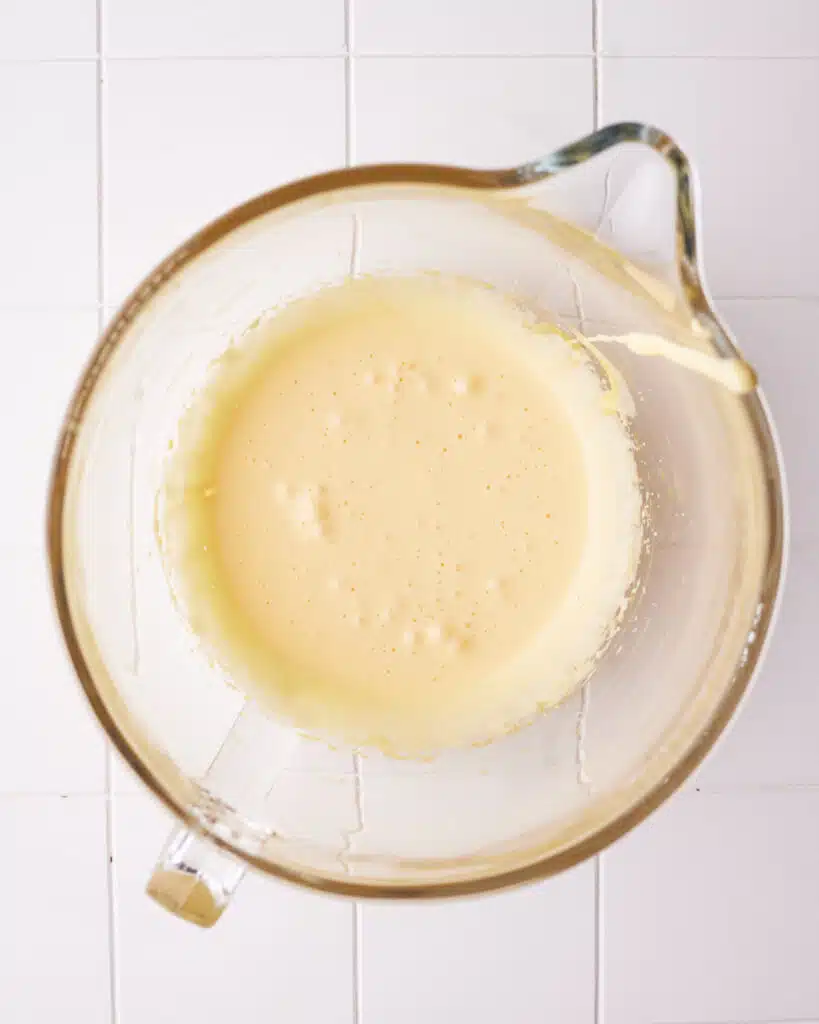
Whip Egg Yolks
Place your egg yolks into the bowl of a stand mixer and whip with a whisk attachment on high speed until they are thick and very pale - almost the color of butter. This may take 5 minutes or so.
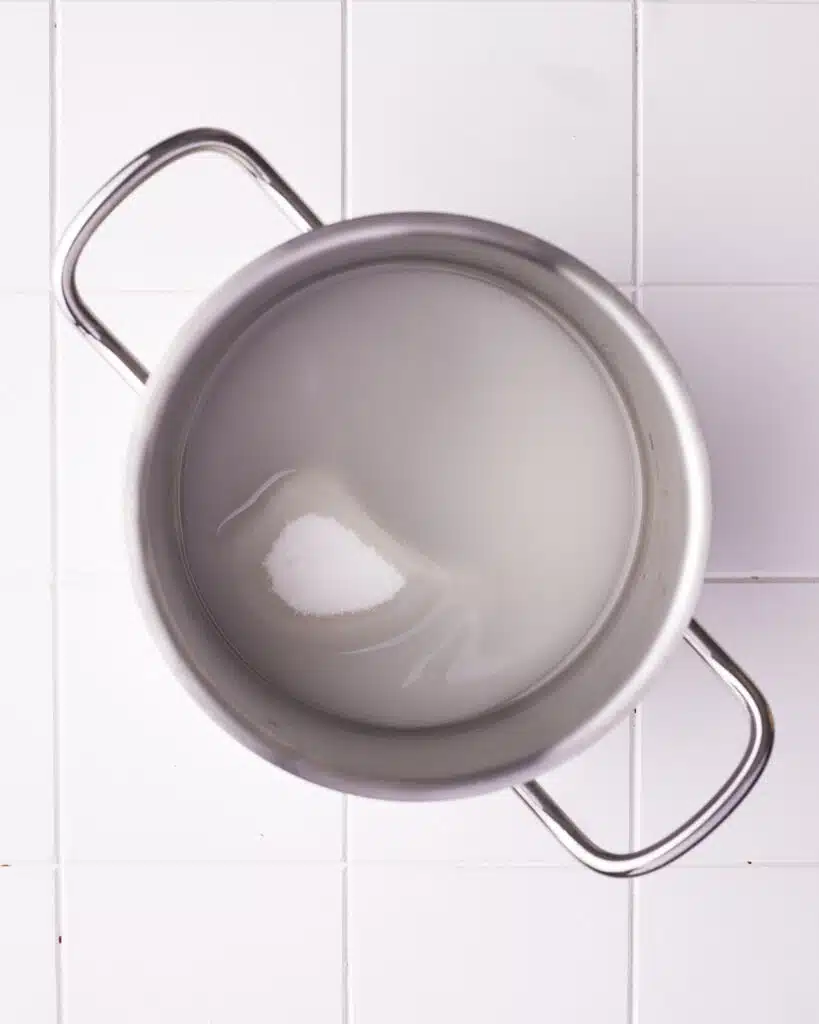
Make Sugar Syrup
Put the sugar and water into a small saucepan over medium heat. Do not stir the sugar mixture.
Use a candy thermometer to monitor the temperature of the sugar syrup as the sugar dissolves and the syrup starts to boil. You want the syrup to reach the softball stage, which is 240°F / 115°C.
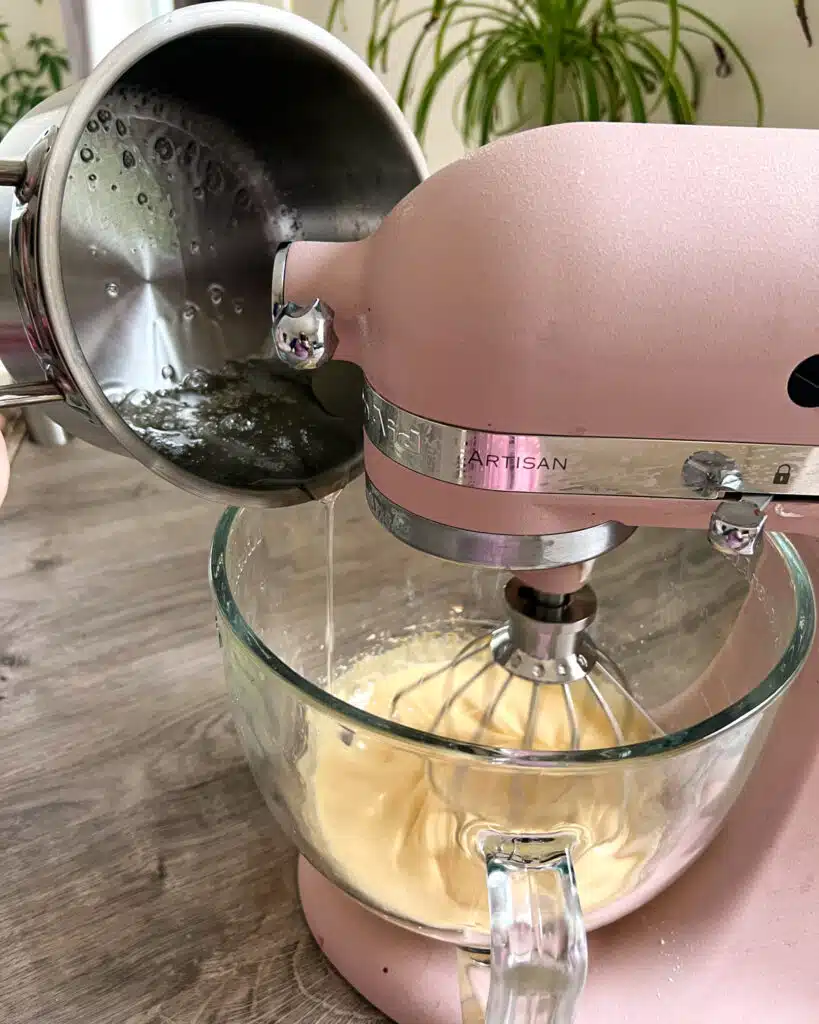
Add Syrup to Eggs
Once the sugar syrup is at the right temperature, turn your stand mixer to low and slowly drizzle the syrup into the whipped egg yolks in a steady stream.
Try not to get it down the side of the bowl or onto the whisk as this can get messy, just pour it slowly and directly into the egg yolks as they mix.
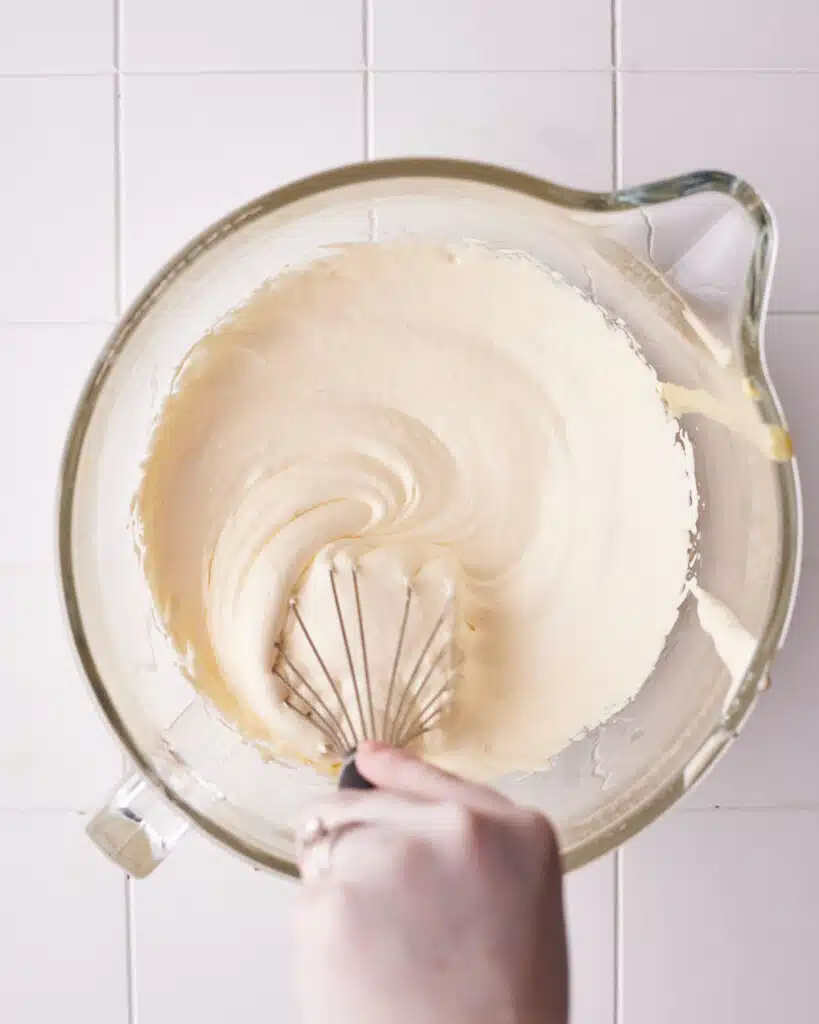
Whip
After all the hot sugar syrup has been added, the side of your bowl will feel warm. Turn the mixer up to high speed and let it whip until the side of the bowl feels room temperature again, this may take 5 - 10 minutes, which is why I don't recommend using a handheld whisk!
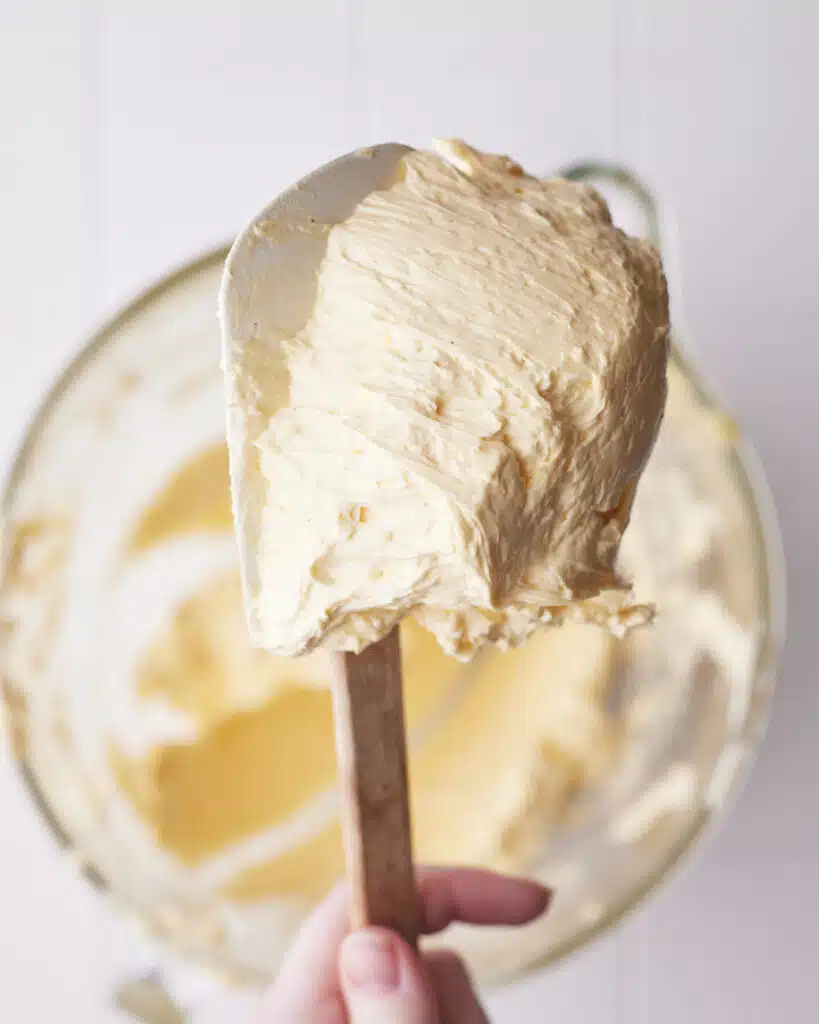
Add the Butter
When the bowl has cooled, you can start adding the butter. It's important that the butter is at room temperature.
Keeping the mixer on high speed, add the butter, one small chunk at a time, letting it incorporate completely in between additions.
At first, the frosting might look a bit gloopy and runny, but don't worry, just keep adding the butter and whipping. Eventually, it will turn into a beautiful, thick, and glossy frosting.
If it doesn't, turn the mixer up to maximum speed and whip for about a minute.

Add the Pistachio Paste
Once all the butter is added, add the vanilla and pistachio paste, then whip until everything is combined.
Taste to check if you'd like to add a touch more salt. This is a purely personal preference, but I feel like the saltiness in this particular recipe really makes it!
Assembly
This pistachio dacquoise cake is super quick and easy to put together. You don't need any kind of decorating skill or special equipment to make this a real showstopper.
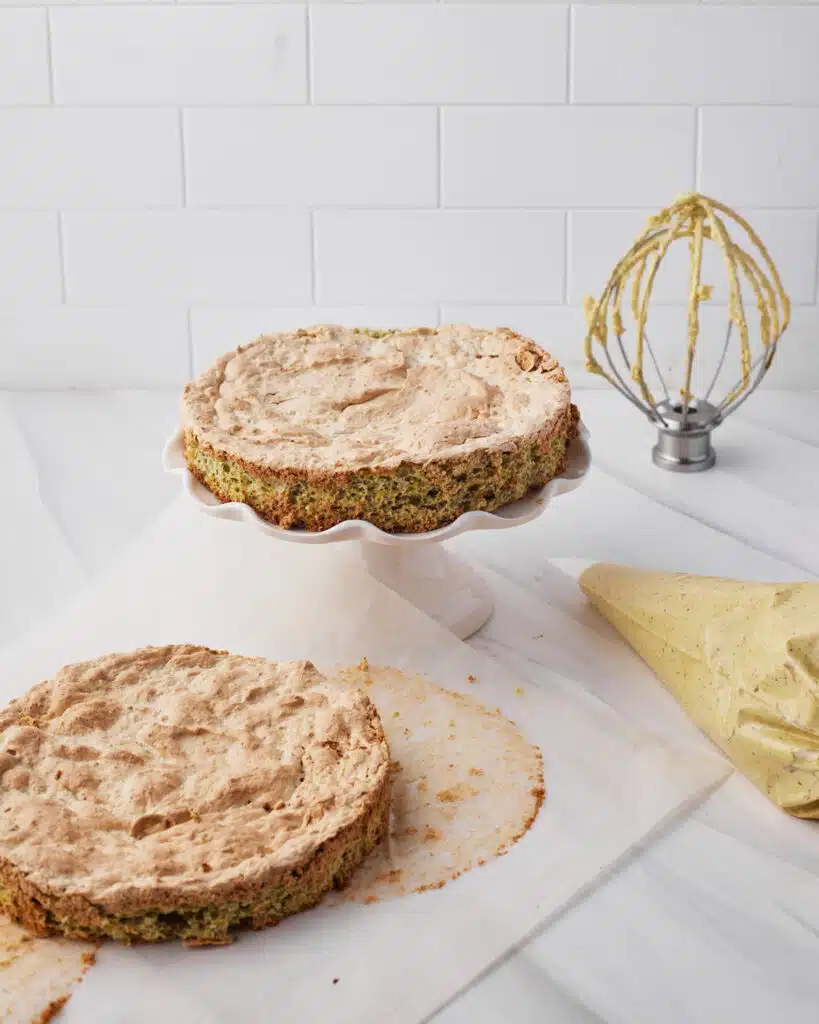
Prepare
Once your dacquoise cakes have cooled and you have removed them from their cake rings, place one of them onto your cake board or serving plate. There is no need to trip off the top or edges - they're perfect to go as they are.
Fill a piping bag or Ziploc bag with your pistachio French buttercream and snip a small opening off the end of the bag. You don't need a piping nozzle for this, just the bag will work great.
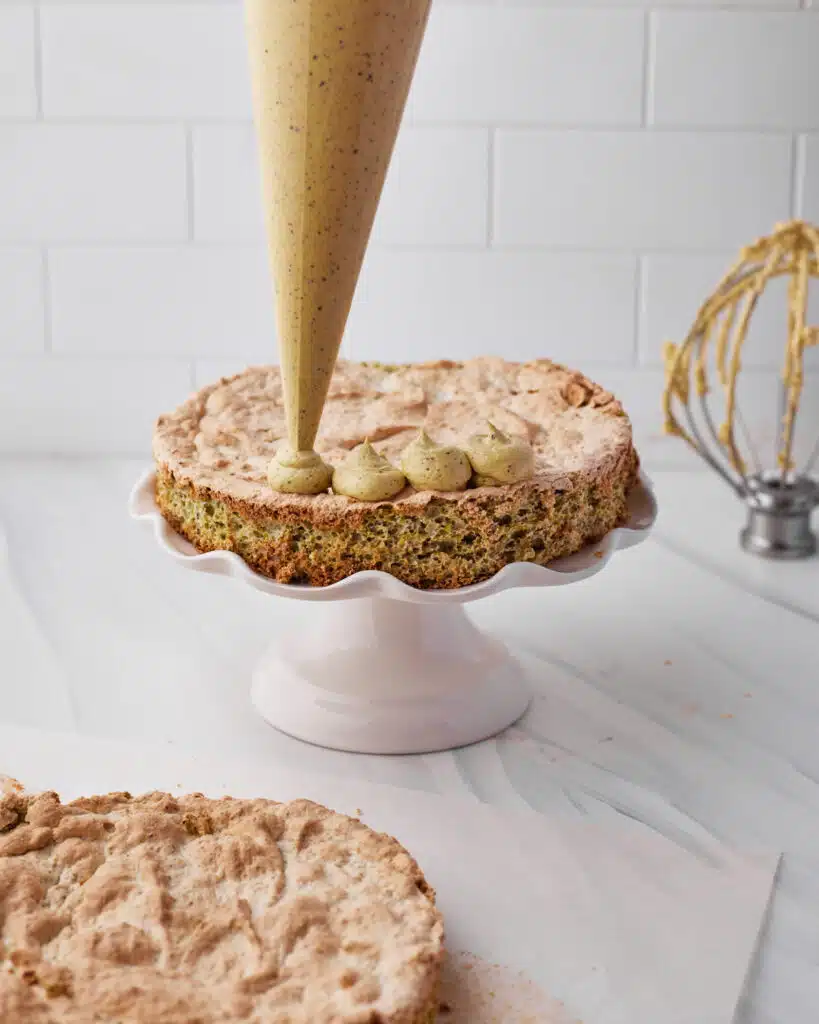
Pipe the Filling
Starting on the outside, pipe little blobs of pistachio frosting around the dacquoise cake. I use a technique where I squeeze slightly the pastry bag and move my hand up just a little as I release pressure.
You can either cover the whole surface in these blobs, or you can just go around the outside and then spread some of the pistachio buttercream in the middle.
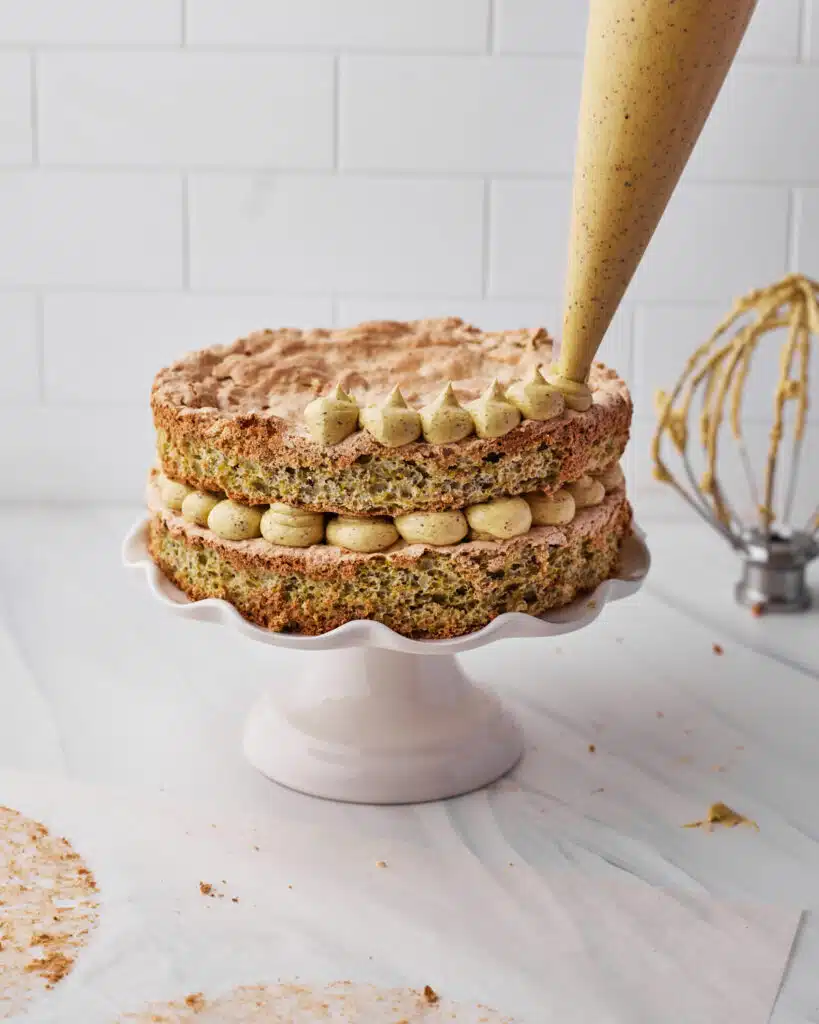
Add the Top Layer
Once the whole layer is covered, place the other dacquoise cake gently on top, then repeat the process and cover the whole top of the cake in pistachio French buttercream blobs.
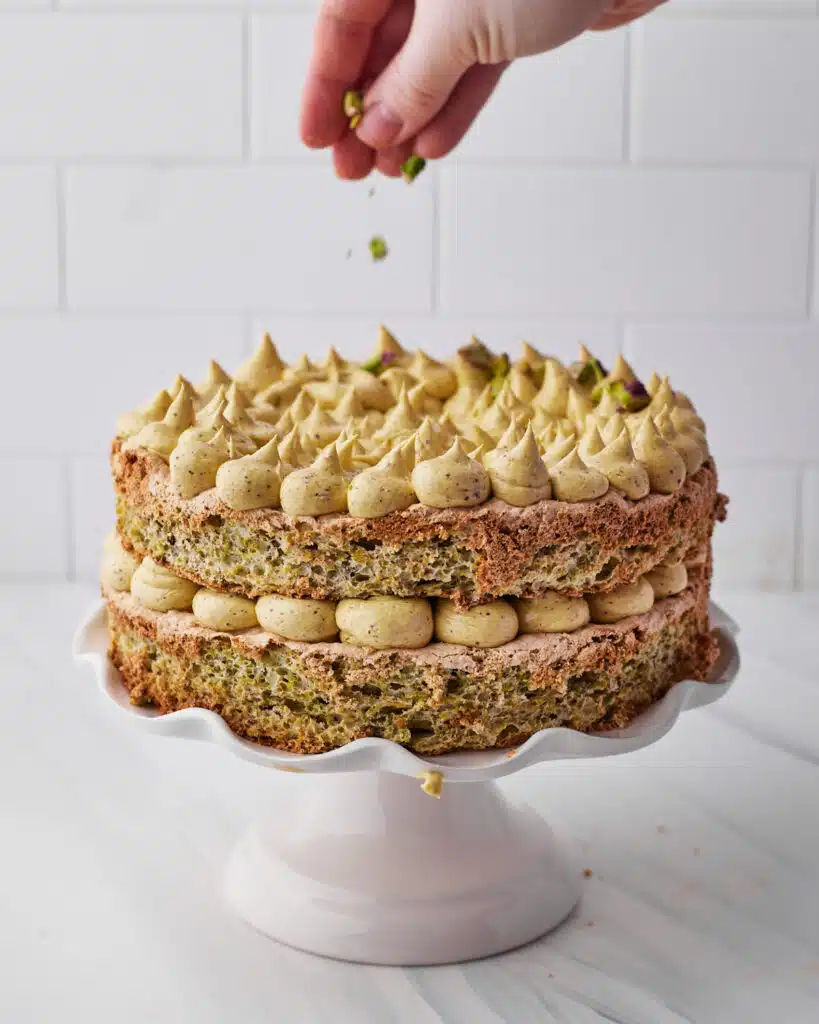
Decorate
For a finishing touch, chop up some pistachios and sprinkle them around the outside edge of the cake.
It really doesn't need much decoration as it looks so impressive as it is!
Different kinds of Dacquoise Cake
There are two main ways to make a dacquoise. Some dacquoise recipes use only meringue and ground nuts to make the dacquoise layer, creating a super crunchy meringue layer that will crumble when you cut into it.
Others, such as this recipe add a little flour to the dacquoise batter. This makes it more stable and adds a slightly softer, springier texture to the dacquoise. It's slightly more cake-like, but still light, chewy, and crispy.
Dacquoise are also often made as small, individual portions rather than a larger layer cake like this one.
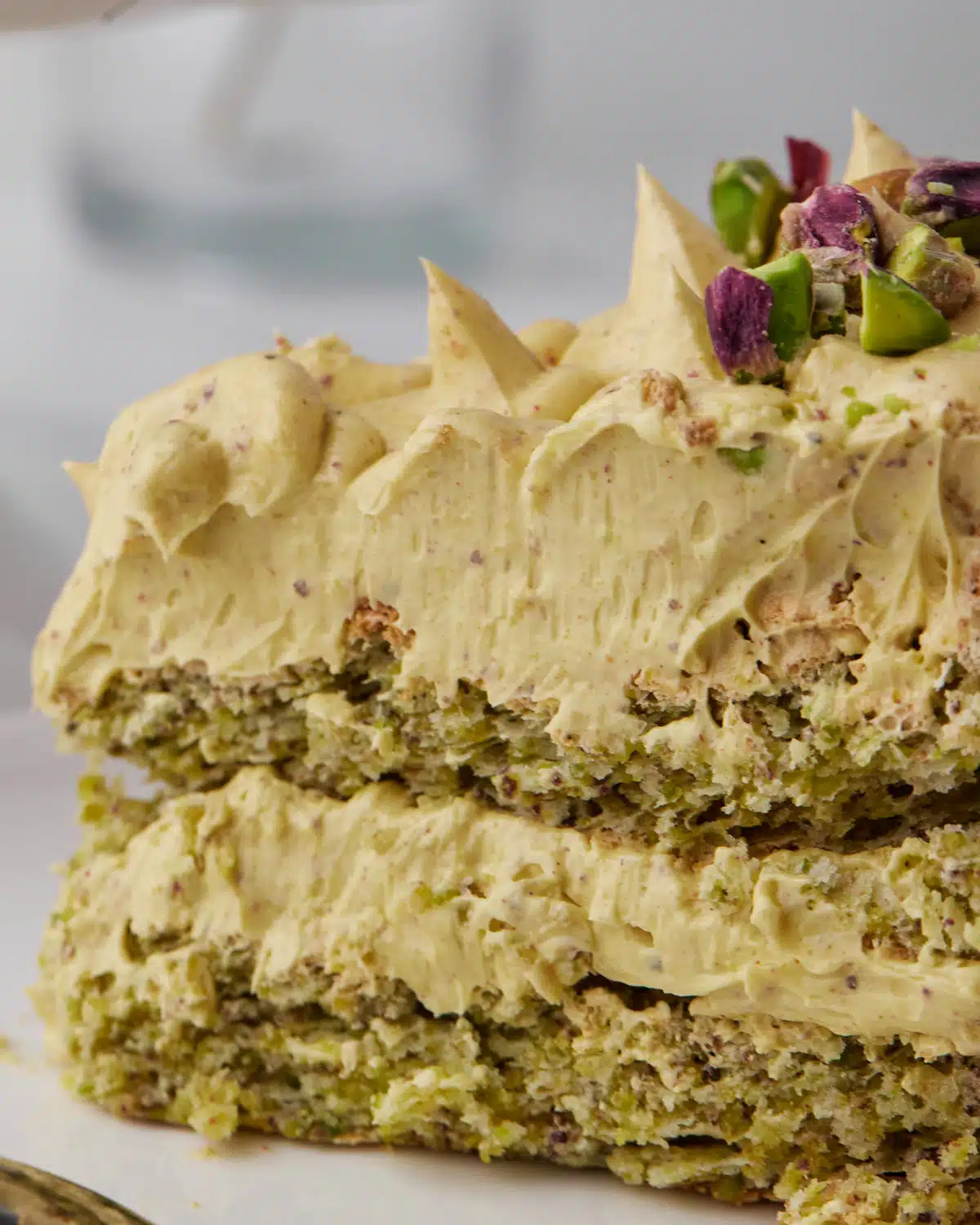
Equipment
- 2 x 7-inch Cake Ring - Also known as a pastry ring or just any kind of stainless steel ring. The ones I used are adjustable and I set them both to 7 inches to make two 7-inch dacquoise layers. You could also use 8-inch rings if that's what you have.
If you don't have cake rings, you can also just spread the dacquoise batter in a circle shape by drawing circles onto parchment paper as a guide. The finished dessert won't be as neat, but it will work.
- Food Processor - The food processor will be used to grind up the pistachios into pistachio flour. If you are making your own pistachio paste you'll also need it for that.
- Stand Mixer with Whisk Attachment - You could use an electric mixer for this, but I strongly recommend a stand mixer as this recipe requires a lot of whisking time.
- Candy Thermometer - to make the French buttercream you'll need a thermometer to get the sugar syrup to the right temperature.
If you don't have a candy thermometer you can watch for when the syrup turns completely clear and has small bubbles all over the surface. You can test if it's ready it by dropping a small amount of the syrup into a glass of cold water - if it turns into a soft, malleable ball then it is ready. If it goes hard like candy, it got too hot and you need to start again.
- Saucepan - You'll need a small saucepan to make the sugar syrup for the French buttercream.
Variations
- Different nuts - You could really make this exact same recipe with any kind of nuts you like, so choose your favorite!
For the dacquoise preparation just grind up whatever nuts you choose, and for the buttercream, you can follow the pistachio butter instructions in this post to make any kind of nut butter you like to add to the frosting
- Alternative filling - I have also tested this recipe with a pistachio cream filling instead of French buttercream. It is also delicious, a little lighter, not so rich, and flavorful.
I spread a layer of pistachio cream on top of the first layer, then folded the remaining pistachio cream into a batch of whipped cream and piped that all over the dacquoise, just like I did with the buttercream.
- Coconut Dacquoise - For an alternative flavor, add some coconut in with your dry ingredients when making the dacquoise cake, then sprinkle some toasted coconut outside of the cake.
- Adding Fruit - For an extra element of flavor, try adding some fresh raspberries to the top of your cake. The tart flavor will balance out with the sweetness of the buttercream.
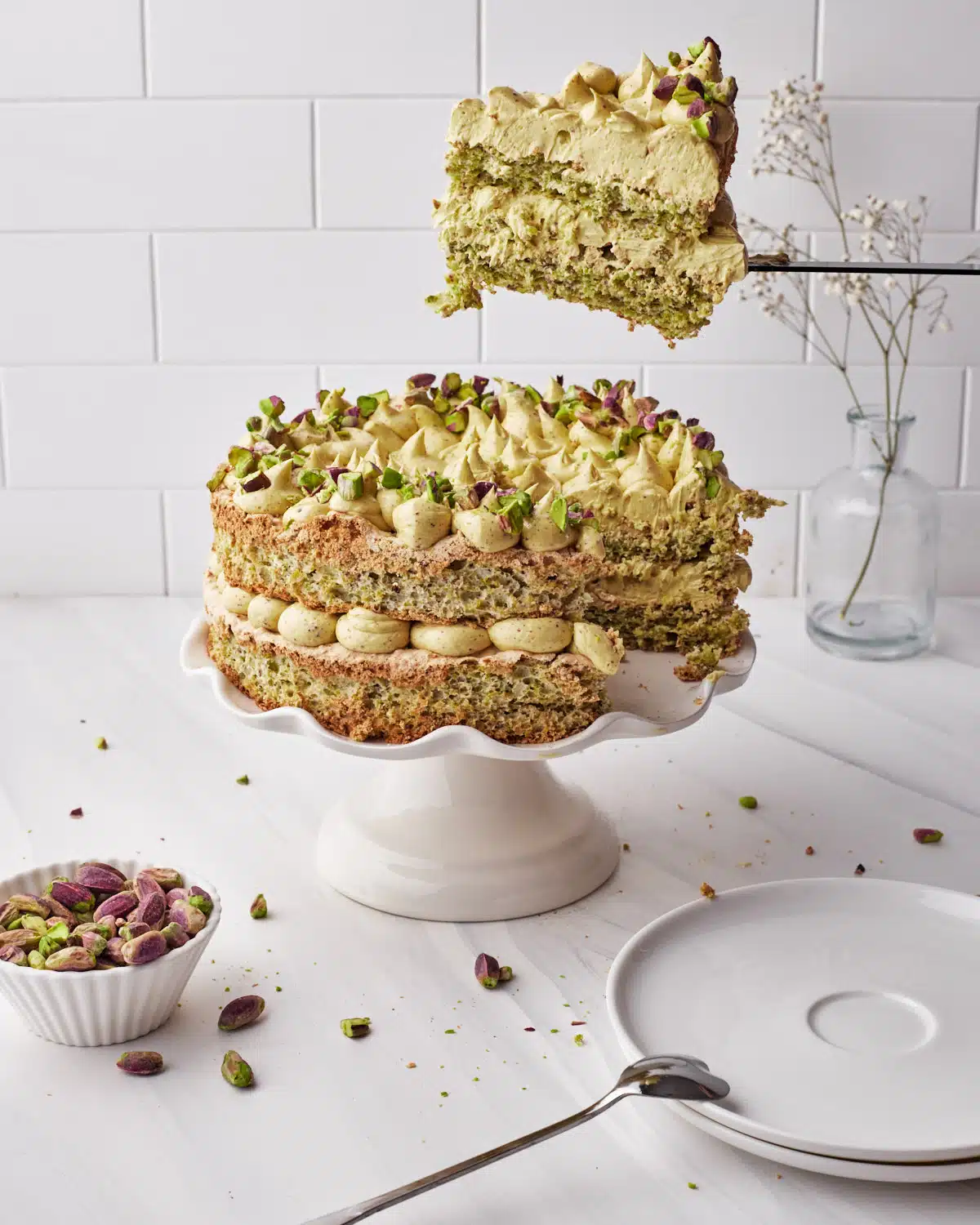
Storage
Once your pistachio dacquoise cake is assembled, store it in the fridge in an airtight container. It will be good like this for 5 days. Serve at room temperature.
How to Serve
Make sure you remove the dacquoise cake from the fridge about an hour before serving as it is best served at room temperature. If you serve it cold, the butter in the French buttercream will be solid and the filling will be hard, rather than soft and creamy.
Making Ahead
If making the French buttercream ahead of time, store it in the refrigerator in an airtight container for up to 2 weeks.
You can freeze buttercream for 3 months but it may lose some of its silky texture. When ready to use, let it come to room temperature, and then whip it up again to restore the glossy texture.
I don't recommend making the dacquoise too far ahead of time as it can dry out, but if you make it the day before, wrap it up in plastic wrap and store it in an airtight container at room temperature.
FAQ
Dacquoise is a French dessert made of meringue mixed with ground nuts and filled with creamy fillings such as buttercream, pastry cream, or whipped cream.
Dacquoise is a French word and is pronounced 'DA-kwahz'.
Yes. If you don't have pastry rings you can just draw 2 7-inch circles onto parchment paper and spread the dacquoise batter inside the lines into a circle shape. The finished dessert won't be quite as neat but it will still look and taste great.
The dacquoise cake itself doesn't need to be refrigerated, but the French buttercream filling does need to be refrigerated.
Once the dacquoise cake has been filled and decorated, store it in the fridge for up to 5 days. Remove from the fridge an hour before serving to allow it to come to room temperature so the buttercream can soften.
Traditionally, dacquoise is made with almonds or hazelnuts, but you can make dacquoise with any kind of nuts such as pistachios or peanuts.
Ground nuts are often featured in French patisserie, like in Opera Cake.
Dacquoise cakes can be filled with various creamy fillings. Some popular choices are French buttercream, pastry cream, sweet whipped cream and chocolate ganache.
Yes. There are two kinds of dacquoise cake, one made with just meringue and ground nuts, and one with a little flour added to the batter. The first will make a harder, crunchier dacquoise cake, whereas the ones with flour will be softer and slightly more sponge-like, but still chewy and a little crispy.
More Pistachio Desserts
If you love this pistachio dacquoise, you may enjoy some of these other pistachio recipes:
Recipe
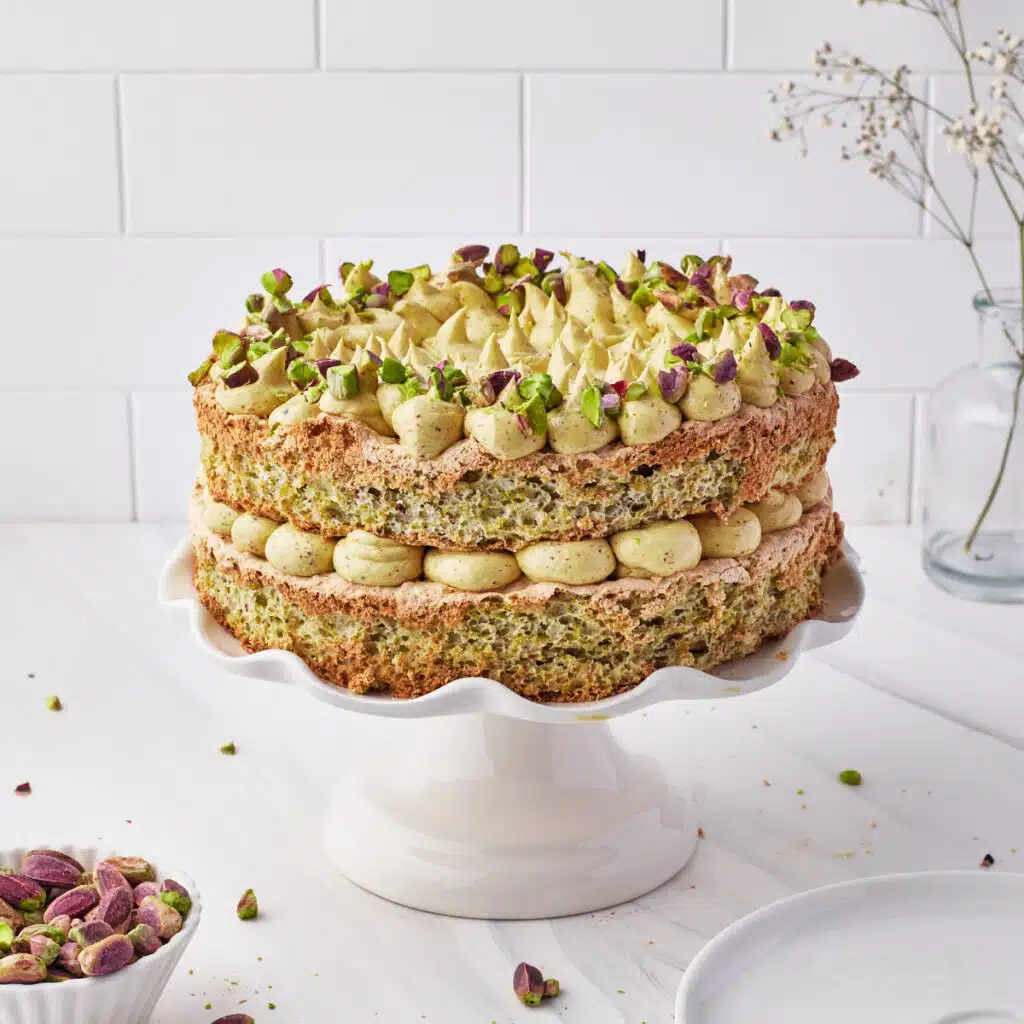
Pistachio Dacquoise
Ingredients
- 5 Large Egg Whites 150g
- ⅝ cup Granulated Sugar 125g
- 1 teaspoon Cream of Tartar (optional*)
- ¼ teaspoon Salt
- 1 ¼ cups Pistachios 150g
- ½ cup Powdered Sugar 50g
- ⅓ cup Cake Flour 40g
- 8 Large Egg Yolks 145g
- ¾ cup Granulated Sugar 150g
- 2 ½ sticks Unsalted Butter 280g (room temperature)
- ⅓ cup Water 80g / 80ml
- 1 teaspoon Vanilla Extract
- 4 tablespoon Pistachio Paste (see my post on how to easily make your own pistachio paste)
- ¼ teaspoon Salt (to taste)
Equipment
- Stand Mixer with Whisk Attachment
Instructions
- Line a large baking sheet with parchment paper and place two 7-inch pastry rings on it, ungreased. Preheat the oven to 465°F / 240°C.
- Add the pistachios to a food processor and grind them up until as finely as you can before they start to release their oils. Don't go too far or you'll end up with pistachio paste!1 ¼ cups (150 g) Pistachios
- Add the flour and powdered sugar to the ground pistachios and pulse until everything is combined. Set aside.½ cup (50 g) Powdered Sugar, ⅓ cup (40 g) Cake Flour
- Make sure the egg whites are room temperature, then whip them up with the cream of tartar and a pinch of salt in a stand mixer or with an electric whisk.1 teaspoon Cream of Tartar, ¼ teaspoon (¼ tsp) Salt, 5 Large (150 g) Egg Whites
- Once the egg whites start to get frothy, start adding the sugar, one tablespoon at a time, whipping for 30-60 seconds in between each addition.⅝ cup (125 g) Granulated Sugar
- Once all the sugar is in, the meringue should be thick and glossy with no more grains of sugar in it. Keep whipping until it reaches very stiff peaks.
- Once the meringue is stiff and glossy, add half of the pistachio flour you made earlier and gently fold it into the meringue. Be careful not to knock too much air out of it.
- Once incorporated, add the remaining pistachio flour and fold that in completely too.
- Divide the dacquoise batter evenly between the two pastry rings and spread it out as flat as possible.
- Put the dacquoise into the oven and immediately turn the temperature down to 350°F / 180°C. Bake for 15 minutes.
- After 15 minutes, turn the oven off and open the oven door slightly. Let the dacquoise sit in there for an hour before moving to the countertop and letting it cool completely in the pastry rings.
- Once completely cooled, run a sharp knife around the edge of the pastry rings and gently release the dacquoise.
- Place the egg yolks into the bowl of a stand mixer with a whisk attachment fitted. Whip them on medium-high speed until they are very pale in color (about the color of butter). This should take about 5 minutes.8 Large (145 g) Egg Yolks
- Meanwhile, heat the sugar and water in a small saucepan on medium heat and bring to a boil. Use a candy thermometer to track the temperature, we want it to get to exactly 240°F / 115°C.¾ cup (150 g) Granulated Sugar, ⅓ cup (80 ml) Water
- Once the sugar syrup reaches the right temperature, turn the mixer down to low speed and carefully pour the sugar syrup into the egg yolks in a slow, steady stream. Be careful not to hit the sides of the bowl or the whisk as you do it.
- The bowl of the stand mixer should feel hot to the touch once all the sugar syrup is in. Turn the mixer up to high speed and let it whip until the bowl feels room temperature again. This may take about 10 minutes.
- Once the bowl feels cool, you can start adding your butter in small chunks. It is vital that the butter is softened, but not too warm. For best results, I like to take my butter out of the fridge about an hour before I start making the buttercream. Add the butter to the mixer one small chunk at a time, letting it whip until it is incorporated in between each addition.2 ½ sticks (280 g) Unsalted Butter
- As you are adding the butter, the consistency of the frosting will change. At first, it will look soupy and runny, don't panic, just keep going. Eventually, the frosting will thicken up and look lovely and glossy. If it doesn't, turn the mixer up to maximum speed and whip for a further minute.
- Once all the butter is added, add the vanilla and pistachio paste and whip on high speed for a minute. Do a taste test and decide if you'd like to add the salt. This is a personal preference, but I love it in there as once it's on the dacquoise cake, it makes a gorgeous sweet and salty contrast.1 teaspoon Vanilla Extract, 4 tablespoon Pistachio Paste, ¼ teaspoon (¼ tsp) Salt
- Place one of the dacquoise cakes on your cake board or serving plate.
- Put the pistachio french buttercream in a piping bag and snip the end off. Squeeze little blobs of buttercream around the outside of the dacquoise.
- You can either add blobs all over the layer, or just do the outer ring and spread some frosting in the middle of the cake.
- Place the other dacquoise layer gently on top of the buttercream and repeat the process, piping blobs of French buttercream all over the top of the cake.
- Decorate with some chopped pistachios around the outside of the cake.

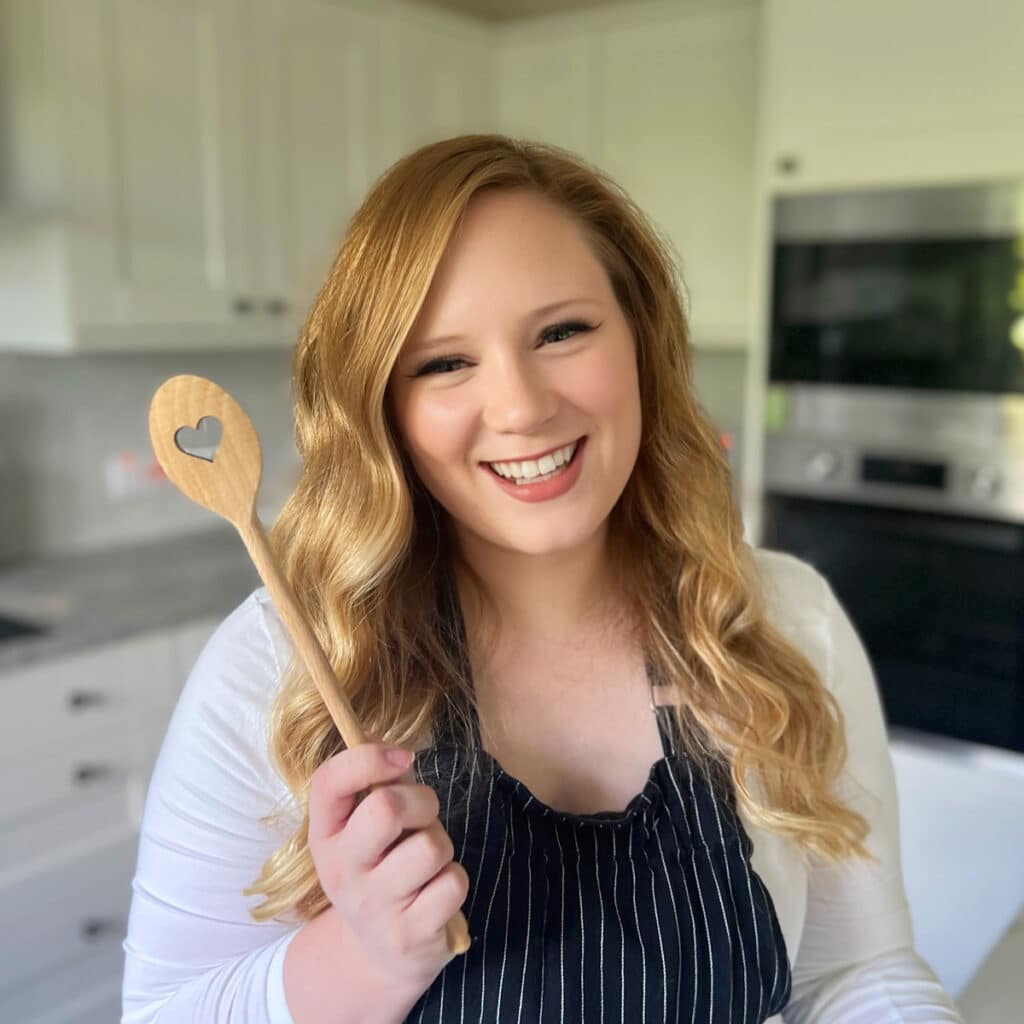
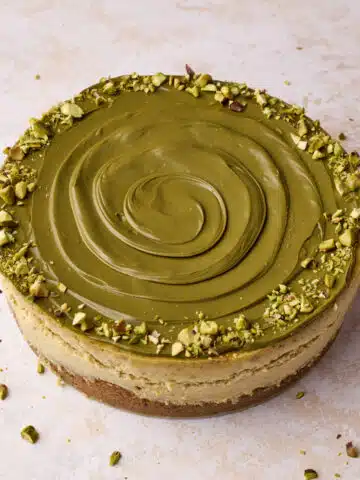
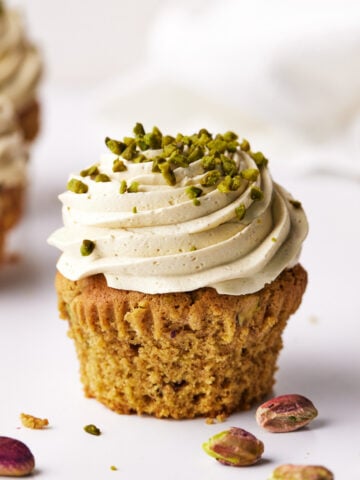
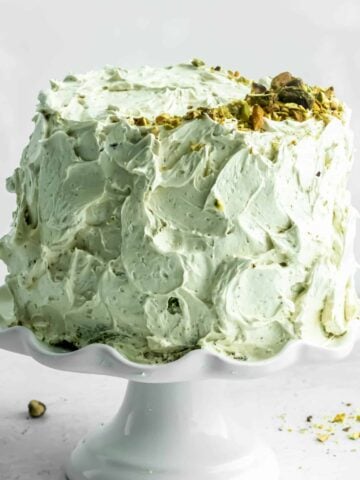
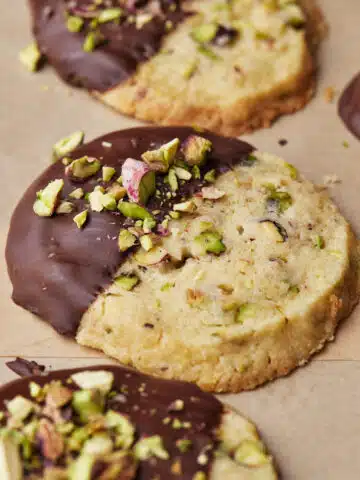


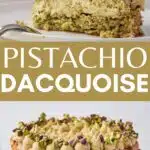
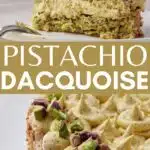

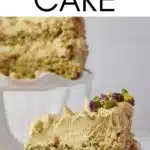
Nikita Kelly
Hello! This looks phenomenal and I plan to bake for Christmas. Regarding the pistachio paste, is this an unsweetened one (akin to making it in the food processor) or a sweetened one not sure what brands are by you, but products like Pisti Pistachio Cream)?
Very excited to give this a crack!
Jules Grasekamp
Hi Nikita,
Oh what a great choice for Christmas dessert! I make it for my family every Christmas too!
You definitely want to use pistachio paste, NOT pistachio cream.
In the ingredients section I have links for both a post with instructions on how to make your own pistachio paste, and a link if you'd rather just order it online.
I'm always happy when people know there is a difference haha.
I hope you love the dacquoise cake and you have a lovely Christmas!
Jules
Alex Messinger
Can you recommend a way to make this gluten free and dairy free? Namely the flour and butter?
cathy
I'm gluten free and have made this many times, substituting the wheat flour with Bob's Red Mill 1:1 gluten free blend. It works perfectly. I can't speak to the dairy free--I've only made it with French buttercream and German buttercream, both of which were fantastic. My favorite comment on this dessert so far is: "one bite changed my life."
Matthew Lilly
Hi! I made an almond berry dacqouise last week which turned out great BUT I folded the almond flour and ground almonds into the batter using a mixer rather than a spatula. I wonder if that caused the meringue to deflate as I had to spread it in cake pans as it was too thin. Is the “fold in” the pistachios done by hand? I’m guessing yes but the other recipe wasn’t clear either. Thanks! Looks fantastic.
Jules Grasekamp
Hi Matthew,
Thank you for your comment, almond berry dacquoise sounds delicious!
Yes I would definitely say that using the mixer here is what caused the meringue to deflate. Unfortunately you can't really fold with a mixer as it just doesn't have the capability to do the right motion. If a recipe says to fold something you should always do this by hand. You want to carefully scoop the ingredients into each other while knocking out as little air as possible. I like to do a big swooping motion round the outside of the bowl with a spatula, and then one stroke down the middle to incorporate, then repeat just until the ingredient is mixed in properly.
I hope this helps!
Jules
Matt Lilly
Thank you for your feedback - the scooping technique worked well for folding the flower mixture into the meringue - it didn’t deflate - but the end product was good, but not the somewhat sticky texture that a pavlova or the other dacquoise (berry with lemon) turned out like. The buttercream frosting was awesome with the pistachio paste , which truly was immensely easy to make in the food processor - but something resulted in it being a little too runny atfter sitting for a bit at room temperature , even after seemingly being thick right at the end of the mixing process. I had to chill it so it wouldn’t lose the nice piping design on top; but of course buttercream tastes best when at room temperature. So bottom line , it was well liked for sure by the guinea pigs - though I probably would have added some other flavor to it so it wasn’t entirely pistachio, like the alternative options you mentioned. I would recommend trying the popular almond berry dacquoise that’s on the internet - an interesting combination of flavors , yet in a huge buttercream fan, and your recipe here was excellent. Thank you for a wonderful addition to our game night experience!
Jules Grasekamp
Hi Matt,
I'm so glad to hear you enjoyed the dacquoise!
Dacquoise is definitely not supposed to be sticky, or soft like pavlova - so that sounds like you nailed it!
The first thing that comes to mind for the french buttercream being runny is that maybe the butter wasn't whipped quite enough - this could make it a little too soft, which could be the problem. Or if the sugar syrup didn't get hot enough, that could also be a potential culprit.
I'm not sure which recipe you are referring to, but it sounds delicious. Thank you for trying my recipe for your game night and I'm so glad to hear you enjoyed it!
Jules
Amy
This was amazing! The flavor of the French buttercream was so rich and creamy, and the cake was moist and airy. Paired perfectly. I made it on a warm day and the frosting didn’t hold up for the beautiful blobs like in the photo, but would have if I had let it cool in the fridge. I used a quality pistachio paste and would splurge again to bring this delicacy to my tastebuds. I’m thinking of trying out a strawberry version this summer with freeze dried and fresh strawberries.
Jules Grasekamp
Hi Amy,
I'm so glad to hear you loved the pistachio dacquoise! Thank you for trying my recipe and for taking the time to let me know!
A strawberry version sounds absolutely delicious! I'd love to know how it turns out!
Jules
Michael
It’s pronounced, da-quay. The “s” is silent. (Google it.)
I would love this, but it’s too involved for me to make.
Matthew Lilly
Google says “The word "dacquoise" is pronounced "dah-KWAHZ". It's a French word, and the pronunciation reflects that origin, with the "qu" sounding like "kw" and the final "e" being silent, according to Merriam-Webster and a YouTube pronunciation guide. “
Virginica D.
I tried the recipe but the amount of Cream of Tartar in the recipe is high and gave the Pistachio Dacquoise a sour taste. My opinion is that to fully enjoy the taste of the cake it is better not to use it.
Jules Grasekamp
Hi Virginica,
Thank you for your comment, I haven't had this issue come up before with this recipe but I will certainly do some more testing to see if the amount could be reduced.
Thank you for your thoughts, and for trying my recipe - I hope you enjoyed the dacquoise cake anyway!
Jules
Bernardita Johnson
Hola, Jules
Muy buen día
De chile te escribo
¿Tiene la harina del daquoise leudante?
¿Tengo que comprar y no sé si comprar con o sin polvo leudante?
Gracias!
Taylor
Are you using raw or roasted pistachios? Very much looking forward to making this next week for my birthday!
Christine Le
It tasted good but the pistachio Dacquoise was quite dense. Perhalf not enought flour ?
Too much butter in the French Buttercream even though I reduced to 2 sticks Instead of 2 1/2
Jules Grasekamp
Hi Christine,
I'm sorry to hear your dacquoise turned out dense. I don't think it could be lack of flour as more flour would make it more dense. It could potentially be that the batter was overmixed, knocking too much air out of the meringue.
Jules